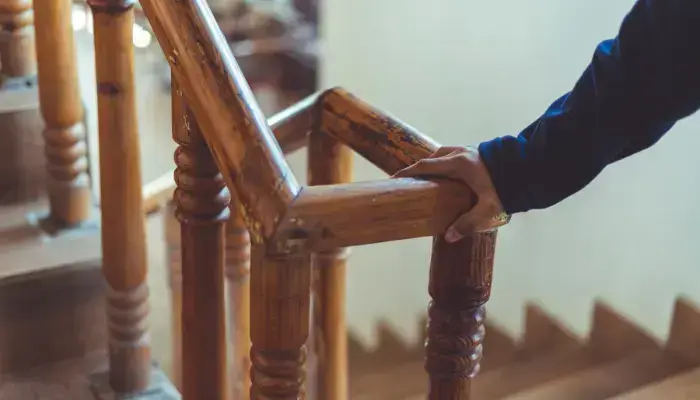According to the Centers for Disease Control and Prevention, approximately 25 percent of adults over the age of 65 fall every year , making it the leading cause of injury for older adults. Although the risk of falling in older adults increases with age, experts caution that falls are not a normal part of the aging process. Here are some practical steps you can take to lower your risk of falling and prevent injuries.
Tips to Lowering Your Fall Risk
1. Visit Your Primary Care Provider

If you are worried about the possibility of a fall, or have already fallen, it’s a good idea to schedule a visit with your primary care provider. A thorough physical can check for any underlying medical conditions that might increase your chances of falling. For example, nerve damage from diabetes or joint inflammation from arthritis may affect your ability to walk, while certain eye and ear conditions can also be considered risk factors.
Dizziness and poor balance are possible side effects of medications used to treat common medical conditions. Bring a complete list of medications you are currently taking to your visit, including prescription and over-the-counter drugs and supplements, so your primary care provider can determine if any of them may increase your risk of falling.
2. Identify and Remove Tripping Hazards

Have a friend or family member help you identify and remove tripping hazards from your home. Start outside and work your way in, looking for things that might increase the risk of falling. These may include:
- Outdoor hazards such as loose pavers in your sidewalk, uneven steps, or large tree roots.
- Dangling power cords.
- Clutter, such as pet items or shoes.
- Area rugs or carpeting that may slide or curl at the edges.
- Slippery areas such as wood or tile floors.
- Elevation changes like indoor stairs or a sunken living room.
- Areas prone to becoming slick, such as entryways or bathroom floors.
Ensure loose items like power cords and clutter, such as pet items, shoes, and magazines, are stored away to prevent tripping.
Periodically check your carpet to ensure it is fully attached to the floor. Consider removing smaller area or throw rugs and replacing them with larger ones that are easier to secure.
Finally, non-slip strips can be added to wood and tile floors for better traction. Non-skid mats are a safe bet in the bathroom – consider adding grab bars if balance is an issue.
3. Make Sure Your Rooms Have Plenty of Light

According to the Mayo Clinic, poor lighting can also increase your risk of falling. Reduce the chances of tripping over objects you can’t see by ensuring each room has plenty of lighting.
Something as simple as keeping a lamp on the night table limits the distance you’ll need to travel in the dark. You can also add motion lights, timers, and underbed lighting to ensure you have illumination where and when you need it.
Finally, consider using smart bulbs and switches, which allow you to control lighting fixtures either by voice or through an app on your smartphone.
4. Keep Items Within Easy Reach
While it might seem sensible to use every inch of available storage space, experts encourage older adults to leave hard-to-reach cabinets empty.
Climbing on a stool or a chair to reach an item that is stored up high can greatly increase the risk of falling in older adults. Heavy or awkward items are better stored at waist height to make it easier – and safer – to access them.
If you need to reach something higher up, use a step stool with rails or hand-holds to ensure you can stay steady. Or, for lighter objects, a simple handheld grabber can allow you to reach without your feet leaving the floor.
5. Exercise

Some older adults may limit their activities, including exercise, out of a fear of falling. However, regular exercise can significantly reduce the risk of falling for older adults. A fitness routine that incorporates strength and balance exercises can be particularly beneficial.
As always, check with your primary care provider before starting a new exercise routine. Consider consulting with a physical therapist who can assess your specific needs and create a detailed program for you. They can also provide modifications and feedback on your form.
Bonus Tip: Select the Proper Footwear
What’s on your feet could be just as important as where they are. Choosing shoes that are sturdy, stable, and comfortable can not only reduce foot and joint pain, but also help you keep your balance and prevent falls.
Look for the following features in a shoe, even for indoor footwear like slippers:
- Heels lower than 1 inch
- A way to close the shoe so that it stays on your foot (like laces or a hook-and-loop closure)
- Thin, hard soles
- Soles with a good tread to prevent slipping
- A supported heel collar that grips your heel firmly
Avoid shoes that do not fit well, those that have a high heel, slip-on shoes, and shoes with soft or worn-out soles.
Fall Prevention Technology at The Bristal
At The Bristal, residents’ health and safety is top of mind. Innovative technology usage like Foresite, a fall management and prediction system, is just one way we’re helping our residents stay independent and prevent injuries.
Foresite is a cutting-edge platform that combines artificial intelligence and no-touch sensors to help reduce falls, monitor health data, and alert the team if a fall has been detected. Its key purpose is to aid our team in understanding each resident’s needs and make informed, wellness-promoting decisions.
Learn more about how we use Foresite to help keep residents safer.



